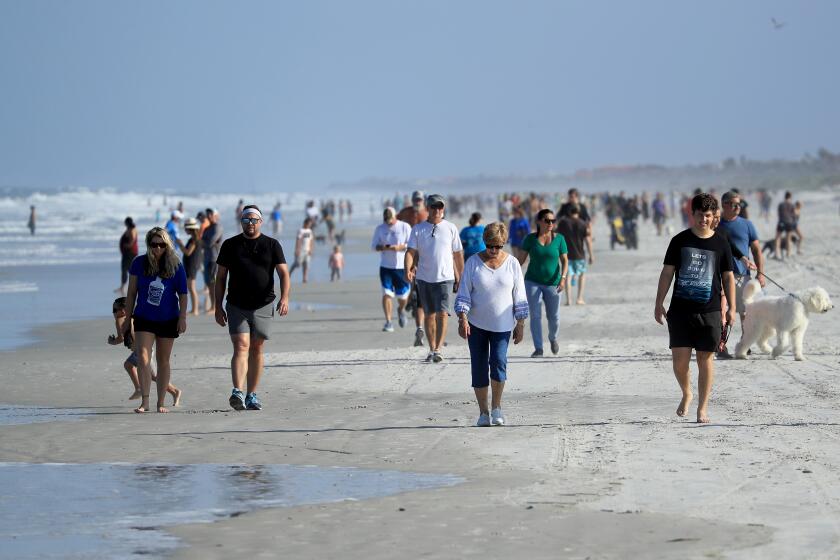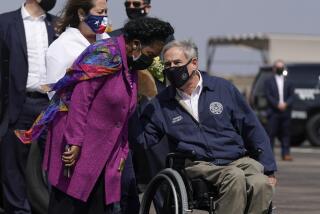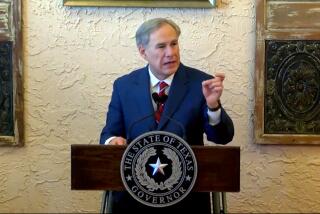Governors will ease coronavirus restrictions under White House plan

- Share via
WASHINGTON — Claiming that the worst of the coronavirus outbreak has passed, President Trump outlined a broad road map Thursday for each state to begin phasing out restrictions that have forced tens of millions of Americans to stay home for weeks, devastating the nation’s economy.
The new guidelines call for a staggered approach over coming weeks and months, but don’t set a date or a deadline.
Instead, authorities in each state — not the federal government — will decide when it’s safe to reopen shops, schools, restaurants, movie theaters, sporting arenas and other facilities that were shuttered to slow the spread of the deadly virus.
“We are not opening up all at once, but one careful step at a time,” Trump said at a White House briefing. “Some states will be able to open up sooner than others.”
The guidance was released on a day the U.S. death toll surpassed 33,000 — more than half as many Americans as were killed in the entire Vietnam War — and an alarming new Labor Department report showed more than 22 million people had filed for unemployment in the last month.
The plan marked a clear reversal for Trump, who had repeatedly vowed a swift restart to the economy — with “a bang,” as he put it — and insisted he could overrule governors.
Florida and Texas ease coronavirus restrictions after pressure from Trump, who insults New York Gov. Andrew Cuomo and defends protesters defying social distancing rules.
He instead bowed to public health experts who warned that moving too quickly — especially without the widespread testing that the government has struggled to deploy since the pandemic began — would jeopardize the fight against the coronavirus and could lead to new outbreaks.
Dr. Anthony Fauci, the nation’s top infectious disease expert, warned that some states may not fully reopen until fall, if then, and that the guidelines were far from foolproof.
“There may be some setbacks,” he said. “Let’s face it. We’re in uncharted waters.”
For Trump, the guidelines acknowledge his limited power to ease local restrictions. Early this week, he declared that he had “total” authority to override governors in deciding when to lift stay-at-home orders, a claim quickly disputed by constitutional scholars and opposed by members of both parties.
But on Thursday, Trump told governors in a conference call to “call your own shots” on when it’s safe to loosen the rules that have sent the economy into a record-shattering nosedive.
The latest evidence emerged early Thursday when the Labor Department reported more than 5.2 million new jobless claims last week. The 22 million job losses in the last month essentially wiped out employment gains since the Great Recession more than a decade ago. Retail sales fell 8.7% in March, the largest monthly decline ever recorded.
Trump still struck a triumphant tone at his news conference, suggesting that victory against the virus was already at hand and that the economy was on the rebound.
“Now that we have passed the peak in new cases, we are starting our life again. We are starting the rejuvenation of our economy again,” he said.
Here’s an inside look with doctors and nurses on the frontlines of the COVID-19 battle.
Although Trump is ceding most responsibility to governors and adopting a slower approach than he initially intended, he’s taking a clear political risk in an election year that the coronavirus could spread in states that have been largely spared so far, or that another wave of infections could hit and force another round of shutdowns.
The new guidelines provide a framework for governors to phase out their restrictions in three stages, but only after they begin to see declining coronavirus caseloads and demonstrate they have sufficient hospital capacity to treat patients.
In the first phase, a state could allow some people back to work, but keep most businesses closed.
If confirmed infections continue to drop, the second phase would allow schools, theaters and bars to reopen and vacation travel could resume. Groups of up to 50 people could gather again, although many people would still be directed to work from home.
In the third phase, elderly and other vulnerable people would no longer be asked to remain at home, and restrictions on working in offices would be lifted.
Dr. Deborah Birx, the White House coronavirus response coordinator, described the final step as a “new normal” for Americans, rather than a return to pre-pandemic life.
Even when most restrictions end, Americans would be encouraged to frequently wash their hands, wear face masks and check their temperatures.
The guidelines will probably pave the way for some states to begin easing restrictions by May 1, when current federal guidelines expire, especially in rural, Republican-led states that have seen fewer infections. But there will be little change in other states that have seen the greatest number of cases.
Authorities in New York and nearby states, the epicenter of the country’s outbreak, as well as states in the mid-Atlantic region, plan to keep restrictions in place for several weeks, if not months.
California has banded together with Oregon and Washington to set their own pace, and several Midwestern states announced Thursday that they would coordinate next steps together.
The new guidelines are intended to allow state and federal authorities to clamp down if there is another outbreak of COVID-19, the disease caused by the coronavirus.
“We know there will be continued hardships and challenges ahead,” Trump said. “Our goal will be to quickly identify and address any outbreaks and put them out rapidly.”
But details on testing, an ongoing hurdle, remained vague.
Under the federal guidelines, states would be required to have enough tests for at-risk health workers and for those who show symptoms of a COVID-19 infection. But they don’t specify how quickly those tests should be available or how they would be provided.
President Trump says he wants to reopen the economy by May 1, but it’s not clear how. Governors and mayors will ultimately decide what to allow.
The omission is likely to stir further debate among public health professionals who say more testing — and tracking of people whom patients had contact with before and after getting infected — is needed before stay-at-home restrictions should end.
Lawmakers pressed Trump on the issue during conference calls on Thursday.
“The sense that I got is that the president is yearning for the economy to be open, and to be open with a boom,” said Rep. Jimmy Panetta, a Carmel Valley Village Democrat who spoke up about testing on the call. “My worry is that if the economy opens too soon, the only boom will be another explosion” of the deadly virus, he said.

After planning to run for reelection on the strength of the U.S. economy, Trump has been desperate to get people back to work and see a rebound in the stock market.
On Tuesday, Trump said he had recruited scores of bankers, corporate chiefs, healthcare executives, labor leaders and others for what the White House called the Great American Economic Revival Industry Groups, saying he intended to seek their advice on the path forward.
But the effort, which included several conference calls Wednesday, appeared to be window dressing. Many of the participants did not know they were included until Trump read their names aloud in the Rose Garden on Tuesday.
On one of the calls, business leaders warned the president that expanded testing was necessary before Americans could safely return to work, but the message was largely drowned out by Trump’s determination to solicit praise from the participants, according to a person briefed on one of the calls.
Eager to show progress in the coronavirus crisis, President Trump meets people who have recovered from COVID-19, but continues to tout unproven drug.
“It was a joke. It was a complete farce,” said the person. “It was not a serious conversation.”
Some executives asked Trump for government protection against legal liability should they reopen and follow health guidelines but are blamed for infections affecting customers, according to another person briefed on the call. Neither person was authorized to discuss the conversation with the president.
The lack of preparation for the calls started another round of finger pointing in the White House among some of the agencies involved, which included the Treasury Department, the National Economic Council and Trump son-in-law Jared Kushner’s team, which is involved in the federal response to the pandemic.
James P. Hoffa, general president of the International Brotherhood of Teamsters, which has 1.4 million members, participated in one of the calls and expressed his disappointment afterward.
“Until we can ensure worker safety, we cannot put our members and workers at further risk by opening the economy up too soon,” he said in a statement. “It’s important that we listen to the medical professionals to ensure that the health and safety of workers and their families is our first priority.”
Although polls show widespread support for continuing social distancing measures until it’s clear the danger has passed, Trump faces pressure to ease the lockdown from some conservative economists, business leaders and media figures, and signs of a backlash appeared in some areas.
Tight restrictions in Michigan, which has suffered the third-highest death toll, drew protests outside state government buildings in Lansing, the capital.
Some protesters brought rifles, wore Trump campaign paraphernalia or waved Confederate flags. Although many stayed in their cars, others crowded together on the sidewalk in defiance of social distancing rules.
Times staff writers Jennifer Haberkorn and Don Lee contributed to this report.
More to Read
Get the L.A. Times Politics newsletter
Deeply reported insights into legislation, politics and policy from Sacramento, Washington and beyond. In your inbox twice per week.
You may occasionally receive promotional content from the Los Angeles Times.

















